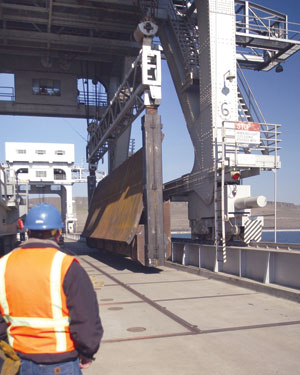forum
library
tutorial
contact

Weir at Little Goose Improves
Fish Passage Efficiency
by StaffHydroWorld, June 2010
|
the film forum library tutorial contact |

|
Weir at Little Goose Improves
by Staff |

The temporary spillway weir (TSW) installed at the 810-MW Little Goose hydro project provides high probabilities of juvenile salmon and steelhead spill passage survival and high spill passage effectiveness, says Chris A. Pinney, fisheries biologist with the U.S. Army Corps of Engineers.
A TSW fits inside a dam's spillway, raising the opening that allows water to pass and allowing juvenile fish to pass near the water surface. This provides a more efficient and less stressful passage route than does diving 50 to 60 feet to pass through a spillway, Pinney says. The TSW at Little Goose, on the Snake River, is about 35 feet tall and 50 feet wide. Advanced American Construction of Portland, Ore., manufactured and installed the TSW. This weir was installed in February 2009, to be tested during the spring 2009 fish passage season.
Preliminary results include survival and passage probabilities from juvenile salmonids passing Little Goose Dam during the spring of 2009. The first study sampled fish equipped with HI-Z Turb'N Tags supplied by Normandeau Associates. The HI-Z tag provides direct survival estimates of spillbay configuration passage. The second study sampled fish equipped with radio tags implanted by U.S. Geological Survey (USGS) personnel. In addition to estimating survival probabilities by a single route (such as the TSW), the Corps requested estimates of fish passage efficiency (the probability of passing via non-turbine routes); fish guidance efficiency (the probability of being diverted into the juvenile bypass system during powerhouse passage); and effectiveness of the spillway, spillway weir, and both routes combined using fish implanted with radio tags and passive integrated transponder (PIT) tags.
Normandeau studied the survival and condition of chinook salmon in passage through Spillbay 1 at two different discharge levels and through Spillbay 8 at a single discharge. New flow deflectors were installed in both spillbays, and Spillbay 1 was equipped with the TSW in March 2009. The TSW was equipped with either a low or high crest weir to accommodate spring and summer flows. Fish were released so their projected path was deep within the TSW discharge jet and mid-level and deep within the discharge jet from Spillbay 8. Results indicated that direct survival of fish passed deep through both the high and low crest TSW weirs in Spillbay 1 were significantly less than the survival of deep or mid-passed fish through Spillbay 8. Although the 48-hour survival was greater through Spillbay 8, fish passing through this spillbay had a higher chance of injuries. The low crest TSW with its higher discharge inflicted the fewest and least severe injuries.
Preliminary results from the USGS indicate that while the TSW was operating, greater than 95 percent of all radio-tagged hatchery yearling chinook salmon, juvenile steelhead, and subyearling chinook salmon passed Little Goose Dam through routes other than the turbine (fish passage efficiency). The TSW with entrainment spill contributed to more than 70 percent of the passage probabilities for chinook salmon and more than 55 percent for steelhead. The TSW alone contributed around a 5:1 ratio of fish to water spilled for chinook salmon and more than a 4:1 ratio for steelhead (spill passage effectiveness). TSW passage survival probabilities for the sample fish were estimated at nearly 100 percent for yearling chinook and steelhead and only a couple of percentage points lower for subyearling chinook salmon. The addition of entrainment spill only reduced the survival probabilities by less than a percentage point.
With the installation of the Little Goose TSW, all four Corps dams on the lower Snake River have surface fish passage facilities. These dams are 603-MW Ice Harbor, Little Goose, 810-MW Lower Granite, and 810-MW Lower Monumental.
learn more on topics covered in the film
see the video
read the script
learn the songs
discussion forum
